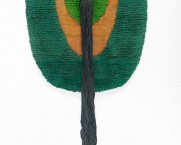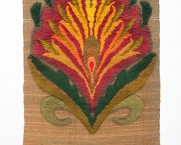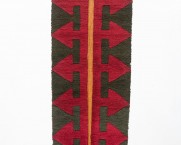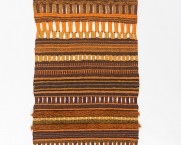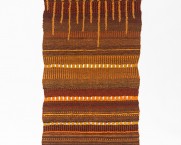C&L Shows
The Unpaved, Crusty, Earthy Road
Nelly Sethna
2021

Overview
This first-ever retrospective of Nelly Sethna (1932-1992) contextualises this all-but-forgotten fibre artist’s versatile and experimental practice: as a weaver, textile designer, researcher and crafts activist.
We present Sethna as a transcultural practitioner, a participant in the global legacy of Nordic modernism through her apprenticeship with Marianne Strengell at the Cranbrook Academy of Art, as well as an inheritor of the ecumenical world-view of Kamaladevi Chattopadhyay in India, which embraced both the traditional and the modern arts.
A research-driven exhibition, this retrospective gathers and interprets empirical evidence to propose a radical model of Sethna’s more than three-decade-long career as comprising several phases, culminating in the expanded, collaborative practice designated here as the ‘Nelly Sethna studio’. While illuminating the distinctive stylistic and conceptual strands in her art, this retrospective acknowledges the role played by Nelly’s various collaborators across the class spectrum at different times in her career – among them Roda Gazdar, Jerbai Shaw, Bhanu, Chandrabhaga, Mansingh, as well as her devoted husband Homi Sethna and her chief associate and soul sister Roshan Mullan.
We include never-before-seen archival material that maps Nelly’s exhibition itinerary from the 1960s to the early 1990s; her research trips to Iran, Kashmir and Kutch; rare documentation of her fibre mobiles, draperies and room dividers from the 1960s, and of her ambitious corporate commissions from the late 1960s, early 1970s for Godrej Bhavan and Express Towers, Bombay and the Ford Foundation, New Delhi; as well as an interview with Roshan Kalapesi that reveals Nelly as a fearless and fiercely independent artist.
A majority of the exhibits are drawn from the Jamshyd and Pheroza Godrej Collection. Pheroza Godrej has long collected outside the sanctified norms of modernist painting, and has championed the works of textile artists, ceramicists and subaltern artists.
The title of the show is a quote from Nelly, who believed that nature was the perennial guide to design. In her own practice, she always courageously chose the unpaved road, and never the road already paved by custom and habit. This, despite the fact that she was debilitated, for the greater part of her life, by the multiple sclerosis that confined her to a wheelchair in 1975.
Nelly has inspired me for many years. My experience of curating this retrospective has been, by turns, exhilarating and frustrating. Exhilarating because every new piece of material evidence – or clues held by fading marginalia – has corroborated a hunch that I was developing through my research. Frustrating because the evidence was so hard to come by, dispersed as it was across uncatalogued information, the fragmentary memories of those who had known her, and folklore that I had to verify against the chronology I was re-constructing.
This research-based exhibition is a first attempt to provide the long arc of Nelly’s practice by carefully inferring and substantiating her multiple artistic genealogies.
As a student, Nelly had defied the head of the commercial arts department at the Sir JJ School of Art, Bombay, who demoted her. She simply picked herself up and sailed to London, with hardly any money, to earn a diploma in textile design and printing at the Regent Street Polytechnic (now the University of Westminster) in 1954-1956. On returning home, she was invited by Neville Wadia to head the first textile design studio at Bombay Dyeing. A chance meeting with Marianne Strengell in Bombay won her a fellowship to study weaving at Cranbrook from 1958-1959.
Many of the principles that Marianne would have imparted to Nelly at Cranbrook are based on the Nordic sloyd system of creating ‘self-made’ products, experimenting with various processes and techniques, and emphasising the problem-solving approach. I would argue that sloyd embodies Nelly’s Nordic modernist lineage. While modernism announced itself as a rupture in most societies, this was not the case in the Nordic countries.
In 1965, Nelly was invited by Gira Sarabhai, co-founder of the National Institute of Design (NID), Ahmedabad, as a consultant to lay the foundations of what would become the NID’s textile design department. Between 1972 and 1974, Nelly was awarded the Homi Bhabha Fellowship to research the dying art of Kalamkari in Masulipatnam and Srikalahasti. She pioneered a revival of Kalamkari by creating new design layouts that could relate to a contemporary sensibility. To this end, she retrieved old hand-carved blocks from long-forgotten godowns and the homes of the Masulipatnam craftspeople. A few years later, she similarly designed new layouts for Kashmir’s crewel embroidery.
Nelly saw the Masulipatnam and Srikalahasti craftspeople as fellow artists. Reflecting on the use of colour in earlier Kalamkari designs, she praises them for their use of “a variety of shades with differing density and an eye-catching sporadic style like that of a choosy painter.” However, despite her love for the crafts and their creators, Nelly remained a product of what I would call a maternalistic approach towards the crafts, strongly associated with her mentor Kamaladevi Chattopadhyay, who revived the crafts in the Nehruvian era by instituting State patronage and support for impoverished craftspersons. The maternalism of Kamaladevi and Pupul Jayakar, as well as Nelly, pulled the craftspeople back from the brink of starvation. But its ingrained class bias and top-down understanding of development ensured that, even on occasions when the craftspeople were able to exert their own creativity, their work became subsumed under the personality cults of elite designers and crafts catalysts.
This exhibition is woven from the warp of affective, visceral experience and the weft of discursive, critical annotation. As the viewer walks through a field of Nelly’s wall hangings from the late 1960s to the 1980s, and from the late 1990s by her chief associate Roshan Mullan, she will encounter haptic works of compelling beauty. A cascade of black threads falls from a green sculptural wall hanging that dates back to the 1980s. We wonder whether it signifies a garland or an elephant caparison. And do the black threads resemble the long hair of Kathakali performers or the mane of an angry goddess? We stand transfixed on the threshold of fantasy and awe.
Intriguingly, the green fibre sculpture is shaped as an inverted arch. The echoing concentric arches, as well as the yantra and the yoni symbols of Tantric sacred diagrams are recurrent motifs in Nelly’s oeuvre. They evoke the sensorium of the utsav, the sacred festivity of high ritual, propitiation and procession. The long magenta-and-black wall hanging, with its optical illusion of arrowheads, is as resplendent as a festival banner.
What is truly fascinating is the way in which the yantra motif is transformed into an Op Art illusion, replete with Fontana-style cuts, in another hanging, in green and orange. Whether it is the twisted bands/ Fontana incisions or the echoing arches in an elegant ten-foot-high wall hanging, we sense Nelly’s preoccupation with nested forms or stories. This ten-foot-high wall hanging may encode her memory of visiting New York in 1964 as a special delegate for the First World Congress of Craftsmen. The tall arches may echo the towering blocks of NYC, surrounded by the foliage of Central Park. Or these great vertical shapes could allude to the dense, grand trees from a Kishangarh painting.
These tactile wall hangings are accentuated through the use of flossa or the Nordic weaving technique of producing a short rug pile that becomes part of the pattern of the hanging. In them, we see the resonances of Tantric diagrams as well as motifs chosen from the Indo-Persianate, Native American and Pre-Columbian repertoires. In Roshan’s wall hanging from 1999, made as a tribute to her mentor Nelly, the Pre-Columbian warrior and bird forms map the transition from Nelly’s symbolic abstraction to Roshan’s affinity for pictoriality.
The retrospective exhibition ends with a portrait of Roshan. Roshan smiles as she poses with dolls that she has made herself. I am struck by the clay figurine in the corner of the frame, also made by her. A mother, or perhaps an older sister, dressed in a Maharashtrian choli and langoti, carries on her back a child whose Greco-Roman head is full of curls. In art-historical terms, this figurine suggests a remnant of a colonial art pedagogy. But that is not the reason why it seizes my attention.
This gesture of carrying another being, of bending with love, of not letting go. I wonder if it had ever crossed Roshan’s mind to leave the Nelly Sethna studio, to strike out on her own. When does love become a burden? How do we perceive Roshan’s absolute devotion to her mentor? As ‘sacrifice’ – a word that, as every woman knows, destroys the self and abrades the soul? Perhaps the Buddhist terms maitri or loving-kindness and karuna or empathy better explain Roshan’s attitude towards Nelly.
~Nancy Adajania
Click here to view the entire virtual tour of this exhibition.

